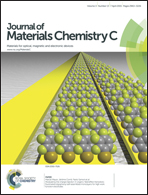Dehydrogenation: a simple route to modulate magnetism and spatial charge distribution of germanane
Abstract
Two-dimensional (2D) materials recently emerged as a new type of nanostructures exhibited large potential for application in nanoscale devices. Nevertheless, many proposed applications require efficient modulation of magnetism and spatial charge distribution within these 2D nanostructures. Here we, via density functional theory (DFT), demonstrated that both magnetism and spatial charge distribution of recently experimentally realized germanane can be effectively modulated via a simple dehydrogenating process. Both single-sided and double-sided H vacancy clusters due to the unpairing of Ge-4p electrons can make germanane obtain magnetism with designated magnitudes. Charges of valence band maximum (VBM) and conduction band minimum (CBM) in germanane that contains single-sided H vacancy clusters can be effectively separated, and charges of VBM and CBM in germanane that contains double-sided H vacancy clusters can be effectively assembled. Thus, our results provide a new perspective on precisely modulating magnetism and spatial charge distribution of germanane, which are fundamentally important for application of germanane in quantum information and optoelectronic fields.


 Please wait while we load your content...
Please wait while we load your content...